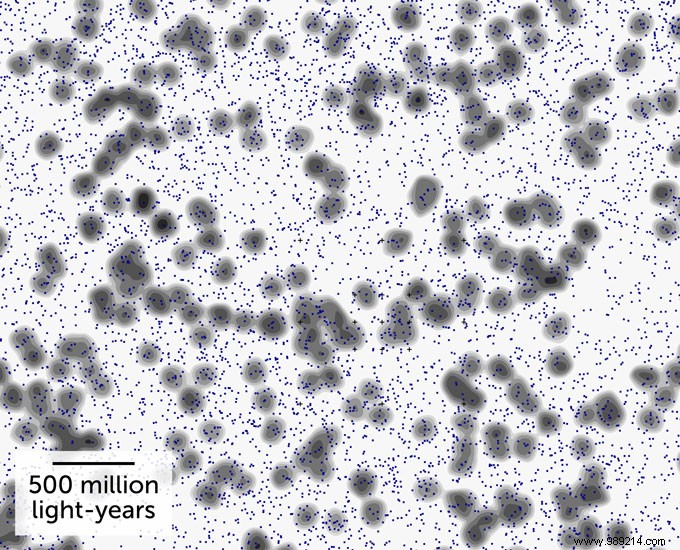A team of astronomers announces that they have isolated a gigantic row of galaxies spanning more than 3.3 billion light years. If the discovery is confirmed, it would be one of the largest structures ever identified in the Universe.
The cosmological principle of homogeneity and isotropy tells us that the Universe is homogeneous in space. In other words, its general appearance does not depend on the position of the observer. Each section of the Universe must therefore be more or less similar. However, in this model, structures spanning more than 1.2 billion light-years are considered "inconsistencies". In other words, it shouldn't exist. However, it is clear that they are present.
In recent years, astronomers have indeed isolated several of them. An example is the Great Wall of Sloan, a giant wall of galaxies spanning more than 1.5 billion light-years in diameter. Or the "South Pole Wall", a similar structure spanning over 1.37 billion light-years.
But it is the Hercules-Corona Borealis Great Wall that breaks all records. This galactic filament located in the constellations of Hercules and Corona Borealis indeed extends over more than ten billion light-years . It is to date the largest and most massive known structure in the observable Universe.
In recent work, a team from the University of Central Lancashire, UK, reportedly identified another such structure consisting of galaxies clustered in the shape of bow. Located 9.2 billion light-years away , this "galactic tail" would span more than 3.3 billion light-years in diameter . And it's starting to do a lot.
“The increasing number of large-scale structures exceeding the size limit of what is considered theoretically viable is becoming increasingly difficult to ignore” , says astronomer Alexia Lopez, lead author of the study presented at the 238th meeting of the American Astronomical Society.
For this work, the researchers relied on data from the Sloan Digital Sky Survey to analyze the light from more than 40,000 quasars . These are very bright galaxies illuminated by the activity of their central supermassive black hole.
When light from these galaxies passes through gas in intergalactic space, certain wavelengths are absorbed. These spectral absorption lines can then be used to map the distribution of matter in the Universe. Here, the signature of this "galactic arc" was in the magnesium atoms that had lost an electron. The light from one of the quasars studied, absorbed by these atoms, indeed seemed to trace an almost symmetrical curve of dozens of galaxies covering approximately one fifteenth of the radius of the observable Universe.
The structure itself is obviously invisible to the naked eye, but if you could see it, it would cover about twenty times the width of the full Moon, underlines Sciencenews .

Finally note that these jobs have a trust level of 99.9997%, or 4.5 sigma. There is therefore still a small degree of uncertainty before we can wait for the 5 sigma gold standard to fully validate the discovery. Follow-up analyzes are already planned.